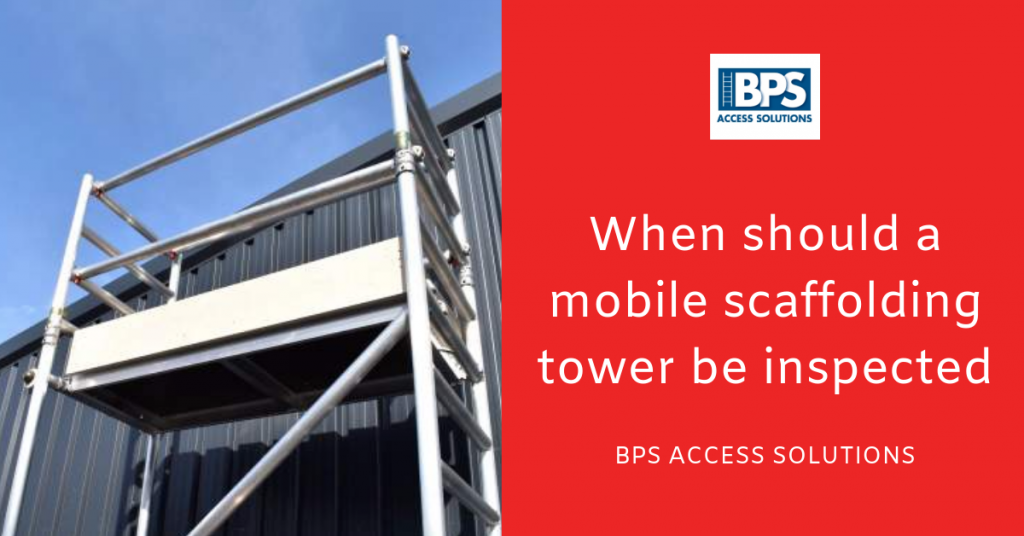When should a mobile scaffolding tower be inspected?
As one of the most integral pieces of equipment on any work site, scaffolding is something that all workers should always be able to depend on. Scaffolding allows workers to perform all manner of tasks at heights which would otherwise be out of reach. It is this height factor which also makes scaffolding one of the most important items to inspect for wear, tear and any other defects which could cause it to fail.
In comparison to standard tube or supported scaffolding, mobile scaffolding towers tend to be moved around, erected and taken down much more frequently. Every time a scaffolding tower is moved or deconstructed, the possibility of small issues or breaks somewhere in the structure is increased.
Bearing this in mind, it can be hard to know what exactly to look out for. Before using a mobile scaffolding tower, all individuals involved in construction and deconstruction of the equipment must be fully trained. This includes all the possible issues and common failure points on scaffolding towers. But that might leave you asking “When should a mobile scaffolding tower be inspected?”.
Below we’ve outlined some guidelines to help you know when to perform equipment checks on your mobile scaffolding tower, and the common issues and potential hazards to look out for.
Things to look out for when inspecting mobile scaffolding towers
The list of considerations featured on mobile scaffolding tower checklists includes all manner of items. From observations about work site surroundings, to making sure all workers are up to scratch with the equipment’s safety guidelines, every item on manufacturer safety checklists serves an important purpose.
Mobile scaffolding towers are subjected to additional wear and tear due to the fact they can be moved around. The fact that they are often also used as a more temporary scaffolding solution also tends to mean that they are left in place for shorter periods of time.
This leads to additional wear and tear on key components. For example, the castors which are used to lock mobile scaffolding tower wheels in place can wear out over time as they are applied and reapplied every time the mobile scaffolding tower is moved. Because mobile scaffolding towers are also usually smaller in size and have less support than conventional scaffolding towers, they are not able to distribute weight as effectively. This technically means that each component takes a larger proportion of the weight of any users and equipment.
When to inspect a mobile scaffolding tower
When it comes to knowing how often a mobile scaffolding tower should be checked, it’s a matter of the more often, the better. According to guidelines by health as safety advisors HASpod, conventional scaffolding structures should be inspected to determine whether they are fit for use or not at least every week.
On top of this bare minimum inspection schedule, additional safety checks should be carried out whenever any event takes place which could have affected the scaffolding. This could include occasions where the scaffolding has been altered or extended in some way, or a case of severe weather which could affect the structural integrity of the scaffolding.
In the case of the mobile scaffolding tower, the Prefabricated Access Suppliers’ and Manufacturers’ Association (PASMA) outlines similar guidelines for inspection and approval of equipment. The main distinction PASMA draws is between mobile scaffolding towers above and below the point where it is possible for users to fall from two metres.
Mobile scaffolding towers above two metres
Mobile scaffolding towers where it is possible to fall from two or more metres should be inspected more frequently than those under two metres, due to the added risk of injury when falling from greater height.
On top of an inspection at least every seven days, PASMA recommends that additional inspections should be carried out when any alteration is made to the structure. This includes completing an inspection report after each assessment and making sure the inspection report complies with the Work at Height Regulations.
Mobile scaffolding towers below two metres
PASMAs guidelines for mobile scaffolding towers below two metres are less strict than those above two metres because there is a smaller risk of injury from a fall. Nevertheless, most of the same basic precautions are required, including checks after assembly, checks before use and checks after events which could have affected the mobile scaffolding tower’s structural integrity.
The main consideration to remember when assessing a mobile scaffolding tower for work-readiness is whether anything could have happened to it to damage its structural integrity. The risk of injury as a result of working with a mobile scaffolding tower is not just limited to falls from height. There are also significant risks posed by objects falling from the work platform, injury as a result of carrying heavy objects up to the work platform, injury during the tower construction process and also the potential for the mobile scaffolding tower to overturn completely.
Bearing these potential risk factors in mind can go a long way in helping you to assess a mobile scaffolding tower for work-readiness both accurately and efficiently.
Another driving factor which is less welcome but still highly effective is the potential penalties which can be handed out to any company which is found to have neglected its responsibilities in the maintenance and assessment of their work equipment.
Failure to provide a safe working environment, whether that is just due to cutting corners or simply a relaxed approach to checking their mobile scaffolding towers, can result in fines totalling many thousands of pounds. For example, a South Yorkshire-based construction contractor was fined £160,000 after a 12-year-old boy suffered life changing injuries after falling from their scaffolding. This fine was handed out even though the boy was not supposed to be playing on the scaffolding because the company had not installed an adequate ladder guard to stop access from the ground.
If you would like to know more about mobile scaffolding towers and the many other access solutions we can help you with, please contact us today.
No related posts.



